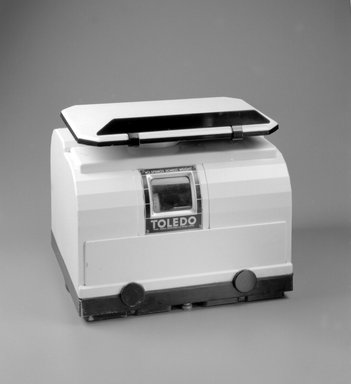
Artist:Harold L. van DorenToledo
Medium: Plastic, metal
Geograhical Locations:
Dates:1930–1940
Dimensions: 15 7/8 x 17 7/8 x 15 3/4 in. (40.3 x 45.4 x 40 cm)
Collections:
Museum Location: Luce Visible Storage and Study Center, 5th Floor
Exhibitions:
Accession Number: 1998.143.1
Image: 1998.143.1_bw.jpg,
Catalogue Description: Sentinel electric scale of white plastic body on black base with metal tray painted white with black edging. Directional orientation based on viewer's perspective if facing "front" side with smaller window. Body is a rectangular box that rises into an angled, rounded top portion at front and back; stands on conforming black (metal?) base of about 1 ½" high raised on metal feet with rubber pads. Front edge of base bulges out slightly at center; two black disks each placed about 4" from side and centered over line where white body meets black base on both front and back of scale. A small, rectangular window with silver-colored and black-painted frame set into the front curved portion of body. Recessed behind curved, colorless plastic windowpane is a vertical band of numbers and gauge lines for pound measurement. A wide rectangular, similarly framed window is set into curved portion of back. This window shows various gauges for measuring: a stationary plate painted yellow and light green marked with black numbers and letters for the one and two-cent graduations (numbers run from 8-34 on one side; from 35-75 with some skipped numbers on other). Through rectangular cut-outs in this plate are visible a horizontal red indicator line (for reading the weight) and vertical columns of numbers and gauge lines that correspond with the graduation markers and move when item is weighed; there is a larger columnar band of numbers and gauge lines down center for actual weight in pounds. Rising from center of top of scale is a short column that supports the weighing tray. Tray is a flat rectangle with notched corners and rounded edges, about as wide as scale's body and several inches shallower. A black, trapezoid shaped metal wall or barrier rises about 1 ½" along front edge of tray and is attached with screws by two struts that wrap around to bottom of tray. Tray moves up and down on column, turning the numbered gauges, when object is placed upon it. Electric cord projects from underside of base at front corner along right side. CONDITION: Fair; shows wear from use; all over scratches, nicks and dirt; black decorative disk on right front is missing; electric cord frayed at base.